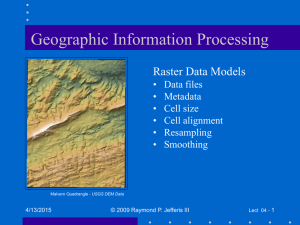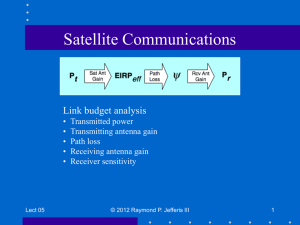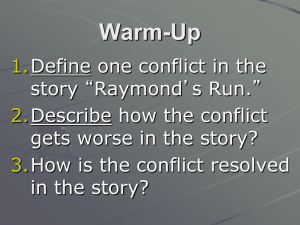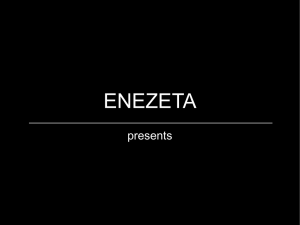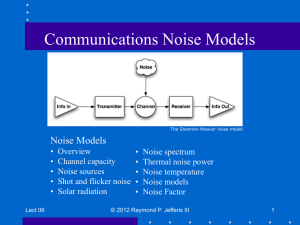Lecture No. 1 - Widener University
advertisement
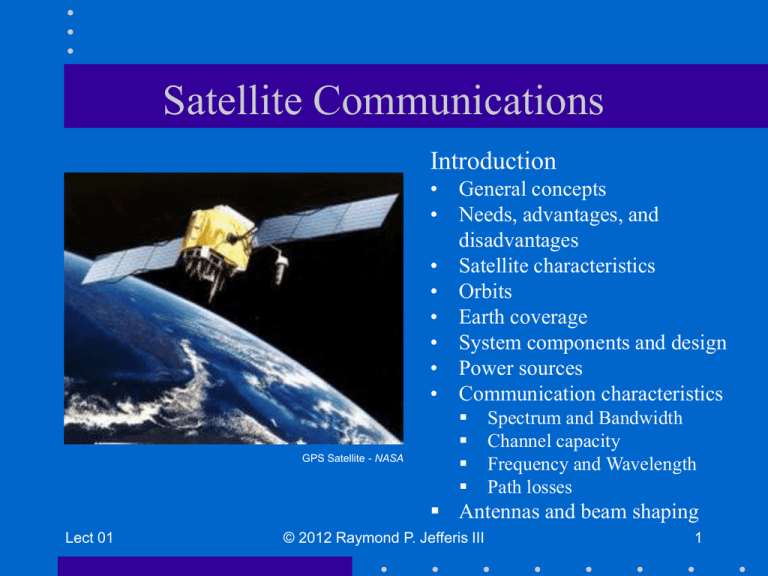
Satellite Communications
Introduction
• General concepts
• Needs, advantages, and
disadvantages
• Satellite characteristics
• Orbits
• Earth coverage
• System components and design
• Power sources
• Communication characteristics
GPS Satellite - NASA
Spectrum and Bandwidth
Channel capacity
Frequency and Wavelength
Path losses
Antennas and beam shaping
Lect 01
© 2012 Raymond P. Jefferis III
1
Text
• Text
– Satellite Communications, Second Edition, T.
Pratt, C. Bostian, and J. Allnut, John Wilen &
Sons, 2003.
Lect 01
© 2012 Raymond P. Jefferis III
2
Other Useful References
Ippolito, Louis J., Jr., Satellite Communications Systems Engineering, John Wiley,
2008.
Kraus, J. D., Electromagnetics, McGraw-Hill, 1953.
Kraus, J. D., and Marhefka, R. J., Antennas for All Applications, Third Edition,
McGraw-Hill, 2002.
Morgan, W. L. , and Gordon, G. D., Communications Satellite Handbook, John
Wiley & Sons, 1989.
Proakis, J. G., and Salehi, M., Communication Systems Engineering, Second
Edition, Prentice-Hall, 2002.
Roddy, D, Satellite Communications, Fourth Edition, Mc Graw-Hill, 1989.
Stark, H., Tuteur, F. B., and Anderson, J. B., Modern Electrical Communications,
Second Edition, Prentice-Hall, 1988.
Tomasi, W., Advanced Electronic Communications Systems, Fifth Edition,
Prentice-Hall, 2001.
Lect 01
© 2012 Raymond P. Jefferis III
3
General Concepts of Satellites:
• They orbit around the earth
– Have various orbital paths (to be discussed)
• They carry their own source of power
• They can communicate with:
– Ground stations fixed on earth surface
– Moving platforms (Non-orbital)
– Other orbiting satellites
Lect 01
© 2012 Raymond P. Jefferis III
4
Needs, Advantages & Disadvantages
• Communications needs
• Advantages of using satellites
• Disadvantages of using satellites
Lect 01
© 2012 Raymond P. Jefferis III
5
Satellite Communications Needs
• Space vehicle to be used as communications
platform
(Earth-Space-Earth, Space-Earth, Space-Space)
• Space vehicle to be used as sensor platform
with communications
• Ground station(s) (Tx/Rx)
• Ground receivers (Rx only)
•
Lect 01
© 2012 Raymond P. Jefferis III
6
List Advantages & Disadvantages
List these on the sheet supplied.
Five minutes allowed.
Lect 01
© 2012 Raymond P. Jefferis III
7
Advantages of Using Satellites
• High channel capacity (>100 Mb/s)
• Low error rates (Pe ~ 10-6)
• Stable cost environment (no long-distance
cables or national boundaries)
• Wide area coverage (whole North America,
for instance)
• Coverage can be shaped by antenna patterns
Lect 01
© 2012 Raymond P. Jefferis III
8
Disadvantages of Using Satellites
•
•
•
•
•
•
Expensive to launch
Expensive ground stations required
Cannot be maintained
Limited frequency spectrum
Limited orbital space (geosynchronous)
Constant ground monitoring required for
positioning and operational control
Lect 01
© 2012 Raymond P. Jefferis III
9
Satellite Characteristics
• Orbiting platforms for data gathering and
communications – position holding/tracking
• VHF, UHF, and microwave radiation used for
communications with Ground Station(s)
• Signal path losses - power limitations
• Systems difficult to repair and maintain
• Sensitive political environment, with competing
interests and relatively limited preferred space
Lect 01
© 2012 Raymond P. Jefferis III
11
Mission Dependent Characteristics
• Orbital parameters
– Height (velocity & period related to this)
– Orientation (determined by application)
– Location (especially for geostationary orbits)
• Power sources
– Solar (principal), nuclear, chemical power
– Stored gas/ion sources for position adjustment
Lect 01
© 2012 Raymond P. Jefferis III
11
Satellite Application Examples
•
•
•
•
•
•
•
Lect 01
Telecommunications
Military communications
Navigation systems
Remote sensing and surveillance
Radio / Television Broadcasting
Astronomical research
Weather observation
© 2012 Raymond P. Jefferis III
12
Orbits
• Have particular advantages and
disadvantages (See text Chapter 1)
• Are determined by satellite mission
• Keppler’s Laws of planetary motion
describe certain orbital properties
(Covered in Lecture 2)
Lect 01
© 2012 Raymond P. Jefferis III
13
Orbital Properties
•
•
•
•
•
Altitude (radius to center of the earth)
Inclination with respect to the earth axis
Period of rotation about the earth
Ground coverage by the satellite
Communications path length(s)
Lect 01
© 2012 Raymond P. Jefferis III
14
Types of Orbit
Dr. Leila Z. Ribeiro, George Mason University
Lect 01
© 2012 Raymond P. Jefferis III
15
Missions Associated with Orbit Types
• GEO
– Primarily commercial communications
• MEO
– Military and research uses
• LEO
– Remote sensing
– Global Positioning Systems
Lect 01
© 2012 Raymond P. Jefferis III
Lect 01 - 16
LEO and MEO Features
•
•
•
•
•
•
Earth coverage requires multiple passes
Typical pass requires about 90 minutes
Signal paths relatively short (lower losses)
Small area, high resolution ground image
Earth station tracking required
Multiple satellites for continuous coverage
(Decreases with increasing altitude - “Telstar”)
Lect 01
© 2012 Raymond P. Jefferis III
17
The Geostationary (Clarke) Orbit
• Arthur C. Clarke, Wireless World, February,
1945, p58.
Lect 01
© 2012 Raymond P. Jefferis III
18
Geo-Synchronous Satellite (GEO) Features
•
•
•
•
•
Appears fixed over point on earth equator
Each satellite can cover 120 degrees latitude
Orbital Radius = 42,164.17 km
Earth Radius = 6,378.137 km (avg)
Period (Sidereal Day) = 23.9344696 hr
(86164.090530833 seconds)
• Long signal path - large path losses
Lect 01
© 2012 Raymond P. Jefferis III
19
GEO Features (continued)
•
•
•
•
Ground image area (instantaneous)
Ground track coverage (multiple orbits)
Stationarity (geostationary orbit)
Space coverage (satellite-satellite)
Lect 01
© 2012 Raymond P. Jefferis III
20
Orbital Altitudes and Problems
• Low Earth Orbit (LEO)
– 80 - 500 km altitude
– Atmospheric drag below 300 km
• Medium Earth Orbit (MEO)
– 2000 - 35000 km altitude
– Van Allen radiation between 200 - 1000 km
• Geostationary Orbit (GEO)
– 35,786 km altitude (42,164.57 km radius)
– Difficult orbital insertion and maintenance
Lect 01
© 2012 Raymond P. Jefferis III
21
Orbital Inclinations
• Equatorial
– Prograde – inclined toward the east
– Retrograde – inclined toward the west
• Inclined
– Various inclination angles with respect to the
spin axis of the earth, including polar
• Geostationary (on equator; no inclination)
• Sun synchronous
Lect 01
© 2012 Raymond P. Jefferis III
22
Earth Coverage Calculation
By the Law of Sines:
rs
d
sin( ) sin( )
and,
90
The elevation angle is approximately,
cos( ) rs sin( ) / d
Lect 01
© 2012 Raymond P. Jefferis III
23
Earth Coverage Calculation (continued)
• The total coverage area on the surface of the
earth, using the previously calculated value
of δ) is given by the equation,
A 2 r (1 Cos[ ])
2
e
Lect 01
© 2012 Raymond P. Jefferis III
24
Try the Calculation Yourself
Show Lect01S24calc.nb Mathematica®®program
Lect 01
© 2012 Raymond P. Jefferis III
25
Sample Calculation [Mathematica®]
re = 6378.137; (* km *)
delta = 32.4171; (* degrees *)
area = 2 p re^2 (1 - Cos[delta Degree]);
Print["Area = ", area, “[km^2]"]
Area = 3.98313*10^7 [km^2]
Lect 01
© 2012 Raymond P. Jefferis III
26
Alternate Earth Coverage Calculation
• Coverage variation as a function of satellite
altitude (rsat)
re
r
sat
Sin 1
rsat
Sin[ ]
re
Sin 1
rsat is the radius to the
satellite from the center of
the earth
A 2 re2 (1 Cos[ ])
Lect 01
© 2012 Raymond P. Jefferis III
27
Calculation: CoverageArea.nb
re = 6378.137; (* km *)
rs = re + hs;
alpha = ArcSin[re/rs]
ad = alpha/Degree
delta = ArcSin[(rs/re)*Sin[alpha]] - alpha
dd = delta/Degree
A = 2 p re^2 (1.0 - Cos[delta])
Plot[A, {hs, 1000, 2000}, AxesLabel -> "Coverage
[km^2]", Frame -> True,
FrameLabel -> {"Altitude [km]", "Coverage [km^2]"}]
Lect 01
© 2012 Raymond P. Jefferis III
28
Earth Coverage vs Satellite Altitude
Lect 01
© 2012 Raymond P. Jefferis III
29
Advanced Earth Coverage Calculations
In:
Orbital Mechanics with MATLAB
http://www.cdeagle.com/html/ommatlab.html
Recommended download:
Coverage Characteristics of Earth Satellites
http://www.cdeagle.com/ommatlab/coverage.pdf
Lect 01
© 2012 Raymond P. Jefferis III
Lect 01 - 30
“Satellite System” Components
•
•
•
•
Satellite(s)
Earth station(s)
Computer systems
Information network
(Example: Internet)
Lect 01
© 2012 Raymond P. Jefferis III
31
Satellite System Design
Satellite network with earth stations.
Lect 01
© 2012 Raymond P. Jefferis III
32
Satellite Components
•
•
•
•
•
•
•
•
•
Receiver (receives on an uplink)
Receiving antenna
Signal processing (decode, security, encode, other)
Transmitter (transmits on a downlink)
Transmitting antenna (beam shaping)
Power and environmental control systems
Attitude control
(De)multiplexing (used in rotating satellites)
Position holding (mission dependent option)
Lect 01
© 2012 Raymond P. Jefferis III
33
Simple Satellite Schematic
Lect 01
© 2012 Raymond P. Jefferis III
34
Satellite Power Sources
• Solar power panels (near-earth satellites)
– Power degrades over time - relatively long
• Radioactive isotopes (deep space probes)
– Lower power over very long life, rarely used.
• Fuel cells (space stations with resupply)
– High power but need maintenance and chemical
resupply, rarely used.
– Example: International Space Station
Lect 01
© 2012 Raymond P. Jefferis III
35
Solar Power
• Power available in orbit: ~1400 watts of
sunlight per square meter
• Conversion efficiency: ~25%
• Useful power: ~350 Watts/square meter
• Panel steering required for maximum power
• Typical power levels: 2 - 75 kW
• Photocell output degrades over time
Lect 01
© 2012 Raymond P. Jefferis III
36
Typical Solar Power Panel Example
Type: GaAs/Ge
Voltage: 53.1 Volts
Power: 1940 Watts
( Effective Load +
Source Resistance:
1.45341 Ω )
Geostationary Operational Environmental
Satellites (GOES) - Ground testing of solar
panels, NASA
Lect 01
© 2012 Raymond P. Jefferis III
37
Satellite Communication Characteristics
•
•
•
•
•
•
Via electromagnetic waves (“radio”)
Typically at microwave frequencies
High losses due to path length
Many interference sources
Attenuation due to atmosphere and weather
High-gain antennas needed (“dish”) to make
up for path loss and noise
Lect 01
© 2012 Raymond P. Jefferis III
38
Communication Characteristics (continued)
•
•
•
•
Spectrum and Bandwidth
Channel capacity
Frequency and Wavelength
Path losses
Lect 01
© 2012 Raymond P. Jefferis III
Lect 01 - 39
Spectrum and Bandwidth
• Electromagnetic spectrum allocations
(“DC to light” – see next slide)
• Bandwidth: the size or “width” (in Hertz)
of a spectrum frequency band
• Frequency band: a range of frequencies in
the available spectrum.
• Channel capacity increases with the
bandwidth (see Slide 42)
Lect 01
© 2012 Raymond P. Jefferis III
40
Electromagnetic Spectrum
Wikipedia
Lect 01
© 2012 Raymond P. Jefferis III
41
Channel Capacity
• The number of error free bits of information
transmitted and received per second
• Shannon (BSTJ, Vol. 27,1938)
The capacity C [bits/s] of a channel with
bandwidth W, and signal/noise power ratio S/N is
S
C W log 2 1
N
Lect 01
© 2012 Raymond P. Jefferis III
42
Frequency and Wavelength Formula
• Microwave energy, at a given frequency, f
[Hz]
• Moves at a velocity, v [m/s]
• And has a wavelength (distance between
peak intensities), [m]
• Formula: = v / f (v = c for space) Note:
The speed of light, c, in a vacuum (space) is
fixed at, c = 299 792 458 [m/s]
Lect 01
© 2012 Raymond P. Jefferis III
43
Frequencies of Interest for Satellites
• Generally between 300 MHz and 300 GHz.
The microwave spectrum
Allows efficient generation of signal power
Energy radiated into space
Energy may be focused (beam shaping)
Efficient reception over a specified area.
• Properties vary according to the frequency used:
Propagation effects (diffraction, noise, fading)
Antenna Sizes
Lect 01
© 2012 Raymond P. Jefferis III
44
Microwaves
• Include frequencies from 0.3 GHz to 300 GHz.
- Line of sight propagation (space and atmosphere).
- Blockage by dense media (hills, buildings, rain)
- Wide bandwidths compared to lower frequency bands.
- Compact antennas, directionality possible.
-Reduced efficiency of generation
•1 GHz to 170 GHZ spectrum divided into bands with letter
designations (see next slide)
Lect 01
© 2012 Raymond P. Jefferis III
45
Designated Microwave Bands
Standard designations
For microwave bands
Common bands for satellite
communication are the L, C
and Ku bands.
Wikipedia
Lect 01
© 2012 Raymond P. Jefferis III
46
Common Microwave Frequency Allocations
• L band
0.950 - 1.450 GHz
Note: GPS at 1.57542 GHz
• C band
3.7 - 4.2 GHz (Downlink)
5.925 - 6.425 GHz (Uplink)
• Ku band
11.7 - 12.2 GHz (Downlink)
14 - 14.5 GHz (Uplink)
Lect 01
© 2012 Raymond P. Jefferis III
47
Common Microwave Frequency Allocations
• Ka band
18.3 - 18.8, 19.7 - 20.2 GHz (Downlink)
30 GHz (Uplink)
• V band
40 - 75 GHz
60 GHz allocated for unlicensed (WiFi) use
70, 80, and 90 GHz for other wireless
Lect 01
© 2012 Raymond P. Jefferis III
48
L-Band GPS Receiver
Lect 01
© 2012 Raymond P. Jefferis III
Lect 01 - 49
L-Band
• Frequencies: 0.950 – 1.450 GHz ( ~30cm)
• Uses:
– Amateur radio communications
– GPS devices
• Features:
–
–
–
–
Lect 01
Patch antenna used for GPS receivers
Low rain fade - Low atmospheric atten. (long paths)
Low power
Small receiver configurations
© 2012 Raymond P. Jefferis III
50
C-Band
Lect 01
© 2012 Raymond P. Jefferis III
51
C-Band
• Frequencies: 3.7 - 6.425 GHz ( ~5cm)
• Uses:
– TV reception (motels)
– IEEE-802.11 WiFi
– VSAT
• Features:
– Large dish antenna needed (3m diameter)
– Low rain fade - Low atmospheric atten. (long paths)
– Low power - terrestrial microwave interferences
Lect 01
© 2012 Raymond P. Jefferis III
52
Ku-Band
Lect 01
© 2012 Raymond P. Jefferis III
53
Ku-Band
• Frequencies: 12 - 18 GHz ( ~ 2cm)
• Uses:
– Remote TV broadcasting
– Satellite communications
– VSAT
• Features:
– Rain, snow, ice (on dish) susceptibility
– Small antenna size - high antenna gain
– High power allowed
Lect 01
© 2012 Raymond P. Jefferis III
54
Ka-Band
• Frequencies: 18 - 40 GHz ( ~ 1cm)
• Uses:
– High-resolution radar
– Communications systems
– Deep space communications
• Features:
– Obstacles interfere (buildings, vegetation, etc.)
– Atmospheric absorption
Lect 01
© 2012 Raymond P. Jefferis III
55
V-Band
• Frequencies: 40 to 75 GHz. ( ~ 5 mm)
• Uses:
– Millimeter wave radar research (very expensive!)
– High capacity millimeter wave communications
– Point-to-point fixed wireless systems (WiFi)
• Features:
–
–
–
–
Lect 01
Rain fade
Obstacles block path
Atmospheric absorption
Expensive equipment
© 2012 Raymond P. Jefferis III
56
Millimeter Waves
• Planck space exploration satellite
– Planck is a flagship mission of the European Space Agency (Esa).
It was launched in May 2009 and moved to an observing position
more than a million km from Earth on its "night side".It carries two
instruments that observe the sky across nine frequency bands. The
High Frequency Instrument (HFI) operates between 100 and 857
GHz (wavelengths of 3mm to 0.35mm), and the Low Frequency
Instrument (LFI) operates between 30 and 70 GHz (wavelengths of
10mm to 4mm).
• Johnson noise problems addressed
– Some of its detectors operate at minus 273.05C
Lect 01
© 2012 Raymond P. Jefferis III
57
Path Losses
• The loss of a radiated signal with distance
• Losses increase with frequency
• Satellites typically require long path lengths
( Path lengths can be over 42,000 km )
Lect 01
© 2012 Raymond P. Jefferis III
58
Causes of Path Loss
• Dispersion with distance
• Atmospheric absorption (Calculated in
Lecture 11)
• Rain, snow, ice, & cloud attenuation
(Calculated in Lecture 12)
• Atmospheric noise effects resulting in
increased Bit Error Rate (BER) (Calculated
in Lecture 6)
Lect 01
© 2012 Raymond P. Jefferis III
Lect 01 - 59
Simple Path Loss Model
• Free-space power loss = (4d / )2
In dB this becomes,
LossdB 32.44 20 log10 (d) 20 log10 ( f )
where:
d is the path distance in
km
f is the frequency in MHz
Lect 01
© 2012 Raymond P. Jefferis III
60
Calculation of Sample Path Loss Model
• Ku band geosynchronous satellite:
f = 15,000 MHz
d = 42,000 km
• LossdB = 32.44 +
20 log10(40,000) +
20 log10(15,000) = 208 dB
• Atmospheric losses must be added to this
Lect 01
© 2012 Raymond P. Jefferis III
61
Atmospheric Attenuation (Loss)
O2
53.5 65.2 GHz
H2O
22.2 GHz
Microwave Attenuation [dB/km] vs Frequency [GHz], Wikipedia
Lect 01
© 2012 Raymond P. Jefferis III
62
H2O vs Dry Air Absorption (Loss)
Lect 01
© 2012 Raymond P. Jefferis III
63
Remedies for Path Loss
•
•
•
•
•
•
•
•
High gain antennas
High transmitter power
Low-noise receivers
Tracking of steered antennas
Modulation techniques
Error correcting codes
Frequency selection
Beam shaping to focus energy
Lect 01
© 2012 Raymond P. Jefferis III
64
Constraints Limiting Path Loss Remedies
• Maximal antenna sizes push satellite radio
wavelengths below 2m.
• Requirements for antenna gain, due to
communication path losses, reduce the
practical wavelengths to below 20cm.
(Diameter, d, of many wavelengths, )
• Dish-Antenna Power Gain = (d/ 2
(where is antenna efficiency)
Lect 01
© 2012 Raymond P. Jefferis III
65
Antenna Gain Calculation
• Ku-Band antenna
Diameter 80 cm (d/ = 40), = 0.6
(about 40 wavelengths at 15GHz)
Power Gain = 0.6*(3.14*40)2 = 15775
GdB = 10 log10[Power Gain ] = 40 dB
Note: Losses and sidelobe effects can reduce
this gain to 60% or less of its possible value.
Lect 01
© 2012 Raymond P. Jefferis III
66
Antenna Gain Efficiency Loss
• From text, p115
d / = 5.6 (4GHz), = 0.35
GaindB = 10 log10 (d/ )2 = 20.9 dB
• From text, p116
d = 9m, = 0.075m (4GHz),
GaindB = 10 log10 (d/ )2 = 49.3 dB
Note: Smaller antenna has lower efficiency.
Lect 01
© 2012 Raymond P. Jefferis III
67
Beam Shaping through Antenna Design
• Antenna radiation patterns (the beam) can be
shaped to redistribute the radiated energy, by
antenna design
• Shaping radiation patterns can increase signal
strength in selected areas
– Allows for more signal energy where higher
noise levels are expected
– Allows energy to be conserved for areas of low
noise or low economic concern
Lect 01
© 2012 Raymond P. Jefferis III
68
Intelsat Galaxy-11 Example
• Location:
• Power:
• Antennas:
– C-Band:
– Ku-Band:
• Transponders:
– 24 channels C-Band:
– 24 channels Ku-Band:
– 16 channels Ku-Band:
Lect 01
91W
Solar, 10.4 KW
2.4m
1.8m
20W each
75W (data)
140W (TV video)
© 2012 Raymond P. Jefferis III
69
Intelsat Galaxy-11 C-Band Coverage
Lect 01
© 2012 Raymond P. Jefferis III
70
Intelsat Galaxy-11 Ku-Band Coverage
Lect 01
© 2012 Raymond P. Jefferis III
71
Conclusions
• Design constraints limit the power avaiable
to satellite communications equipment
• Path losses limit communication capacity
• High gain antennas can overcome some
limitations
• Antenna patterns can be shaped to favor
desired locations on the earth
Lect 01
© 2012 Raymond P. Jefferis III
72
Questions?
Lect 01
© 2012 Raymond P. Jefferis III
73
Reminders
• Check access to a math package
(Mathematica® or MATLAB®)
• Do homework
Lect 01
© 2012 Raymond P. Jefferis III
74
End
Lect 01
© 2012 Raymond P. Jefferis III
75
